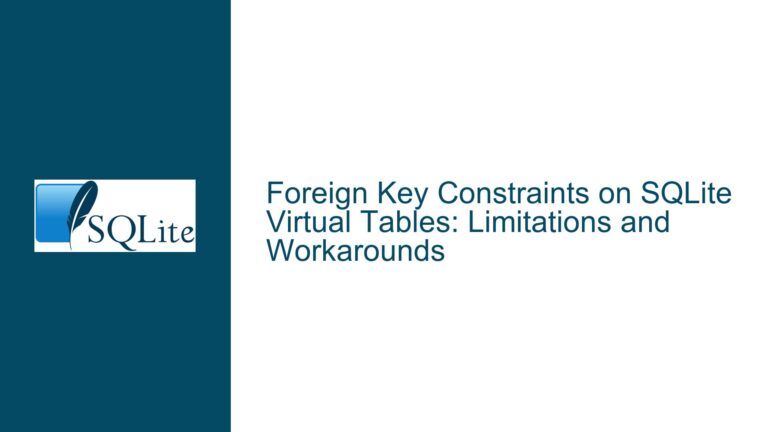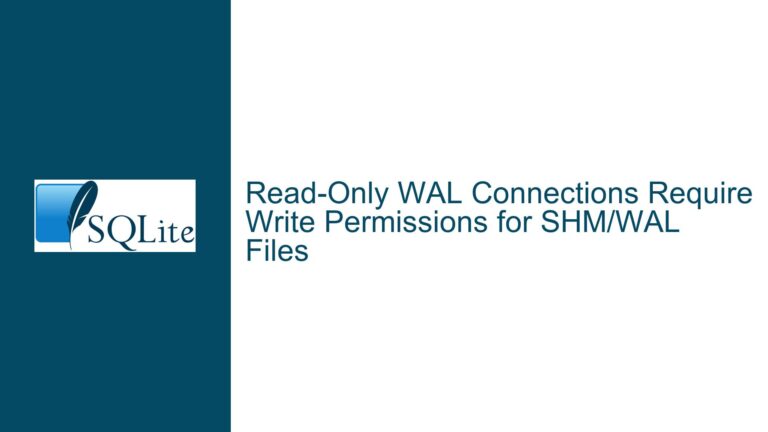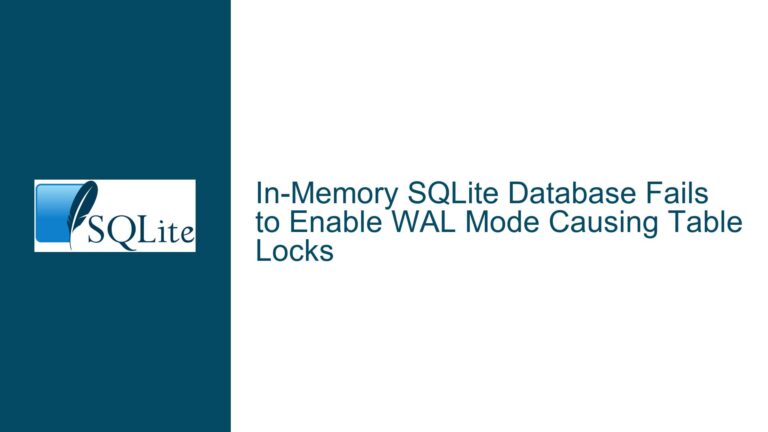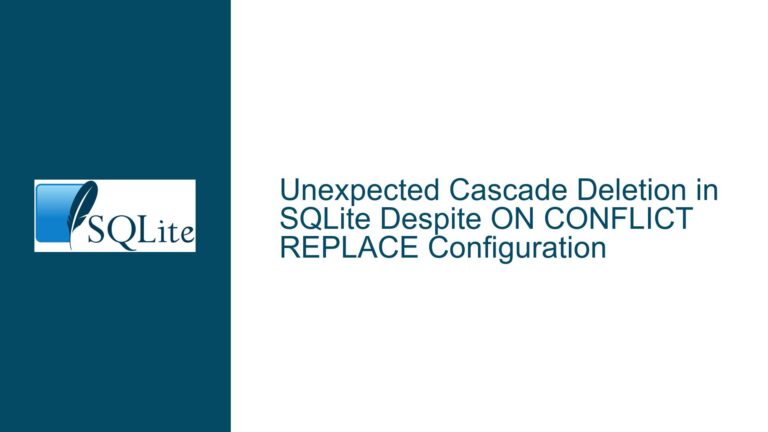Accessing Legacy RC4-Encrypted SQLite Databases with SEE: Migration and Compatibility
Understanding the Compatibility Between Legacy RC4 Encryption and SQLite Encryption Extension (SEE)
When dealing with legacy databases encrypted using the CryptoAPI with RC4 encryption, transitioning to the SQLite Encryption Extension (SEE) presents a unique set of challenges. The primary issue revolves around the incompatibility between the legacy RC4 encryption method and the newer encryption mechanisms supported by SEE. This incompatibility stems from the differences in how encryption is implemented at the page level, particularly with the introduction of per-page nonce in SEE’s RC4 implementation. This section will delve into the specifics of why these two encryption methods are not directly compatible and what this means for database access and migration.
Legacy RC4 encryption, as used in older versions of System.Data.Sqlite, does not incorporate a per-page nonce. This means that the encryption process is applied uniformly across the entire database without the added security layer of unique nonces for each page. In contrast, SEE’s implementation of RC4 includes a per-page nonce, which significantly enhances security but also introduces a fundamental difference in how the encryption is handled. This difference is the root cause of the incompatibility, as the encryption schemes are not interchangeable without a migration step.
The documentation for SEE suggests that it supports RC4 encryption, which might lead one to believe that legacy databases encrypted with RC4 can be accessed directly using SEE. However, this is not the case due to the aforementioned differences in encryption implementation. The documentation does provide a method, SQLiteConnection.DecryptLegacyDatabase(), which is designed to facilitate the migration of legacy databases to a format compatible with SEE. This method decrypts the legacy database and re-encrypts it using the newer encryption scheme, thereby making it accessible via SEE.
The necessity of this migration step raises important considerations for software developers and database administrators. For instance, when upgrading to a new version of software that utilizes SEE, it is crucial to plan for the migration of legacy databases. This planning should include not only the technical steps required for migration but also the impact on end-users, particularly in terms of downtime and data integrity. The migration process must be carefully managed to ensure that data is not lost or corrupted during the transition.
Moreover, the incompatibility between legacy RC4 encryption and SEE has implications for backward compatibility. Developers must decide whether to enforce a migration step for all users or to maintain support for legacy encryption methods. This decision will depend on various factors, including the size of the user base, the criticality of the data, and the resources available for managing the migration process. In some cases, it may be feasible to support both encryption methods temporarily, allowing users to migrate at their own pace. However, this approach adds complexity to the software and may not be sustainable in the long term.
In summary, the incompatibility between legacy RC4 encryption and SEE is a significant issue that requires careful consideration and planning. The differences in encryption implementation, particularly the use of per-page nonce in SEE, mean that a migration step is necessary to make legacy databases accessible via SEE. This migration process involves decrypting the legacy database and re-encrypting it using the newer encryption scheme, which can be achieved using the SQLiteConnection.DecryptLegacyDatabase() method. Developers must weigh the pros and cons of enforcing migration versus maintaining backward compatibility, taking into account the impact on end-users and the overall sustainability of the software.
Exploring the Necessity of Database Migration for Legacy RC4-Encrypted Databases
The necessity of migrating legacy RC4-encrypted databases to a format compatible with the SQLite Encryption Extension (SEE) is a critical consideration for developers and database administrators. This migration is not merely a technical formality but a fundamental requirement for ensuring continued access to data when upgrading to newer versions of software that utilize SEE. The migration process involves decrypting the legacy database and re-encrypting it using the newer encryption scheme supported by SEE, which includes the use of per-page nonce for enhanced security.
One of the primary reasons for this migration is the incompatibility between the legacy RC4 encryption method and the newer encryption mechanisms supported by SEE. As previously discussed, the legacy RC4 encryption does not incorporate a per-page nonce, whereas SEE’s implementation of RC4 does. This difference in encryption implementation means that legacy databases cannot be accessed directly using SEE without first undergoing a migration process. The SQLiteConnection.DecryptLegacyDatabase() method is specifically designed to facilitate this migration, ensuring that the data remains secure and accessible.
The migration process is not without its challenges. For one, it requires careful planning and execution to ensure that data is not lost or corrupted during the transition. This involves creating backups of the legacy database before initiating the migration, as well as verifying the integrity of the data after the migration is complete. Additionally, the migration process may require downtime, particularly for large databases, which can impact end-users. Developers must communicate clearly with users about the need for migration and provide guidance on how to proceed.
Another consideration is the impact of migration on backward compatibility. While it is possible to maintain support for legacy encryption methods temporarily, this approach adds complexity to the software and may not be sustainable in the long term. Developers must decide whether to enforce migration for all users or to allow a phased transition, where users can migrate at their own pace. This decision will depend on various factors, including the size of the user base, the criticality of the data, and the resources available for managing the migration process.
In some cases, it may be feasible to support both encryption methods temporarily, allowing users to migrate at their own pace. However, this approach requires additional development effort to ensure that the software can handle both encryption schemes seamlessly. It also introduces the risk of data inconsistencies if users delay migration for an extended period. Therefore, while temporary support for legacy encryption methods may be a viable option in some scenarios, it is generally advisable to enforce migration as soon as possible to ensure data security and consistency.
The migration process also has implications for data security. By migrating legacy databases to the newer encryption scheme supported by SEE, developers can take advantage of the enhanced security features, such as the use of per-page nonce. This not only improves the overall security of the data but also ensures compliance with modern security standards. In an era where data breaches and cyberattacks are increasingly common, ensuring the highest level of data security is paramount.
In summary, the necessity of migrating legacy RC4-encrypted databases to a format compatible with SEE is a critical consideration for developers and database administrators. The migration process involves decrypting the legacy database and re-encrypting it using the newer encryption scheme supported by SEE, which includes the use of per-page nonce for enhanced security. While the migration process presents challenges, such as the need for careful planning and potential downtime, it is essential for ensuring continued access to data and maintaining data security. Developers must weigh the pros and cons of enforcing migration versus maintaining backward compatibility, taking into account the impact on end-users and the overall sustainability of the software.
Step-by-Step Guide to Migrating Legacy RC4-Encrypted Databases to SEE
Migrating legacy RC4-encrypted databases to a format compatible with the SQLite Encryption Extension (SEE) is a multi-step process that requires careful planning and execution. This section provides a detailed guide to help developers and database administrators navigate the migration process, ensuring that data remains secure and accessible throughout the transition.
Step 1: Backup the Legacy Database
Before initiating the migration process, it is crucial to create a backup of the legacy database. This backup serves as a safety net in case anything goes wrong during the migration. The backup should be stored in a secure location, and its integrity should be verified to ensure that it can be restored if necessary.
Step 2: Install the Necessary Software
Ensure that the latest version of System.Data.Sqlite with SEE support is installed. This version should include the SQLiteConnection.DecryptLegacyDatabase() method, which is essential for the migration process. Additionally, verify that all dependencies are up to date and compatible with the new version.
Step 3: Decrypt the Legacy Database
Using the SQLiteConnection.DecryptLegacyDatabase() method, decrypt the legacy database. This method will read the legacy RC4-encrypted database and write a decrypted version to a new file. It is important to specify the correct connection string, including the prefix for the legacy encryption mode (e.g., "rc4").
Step 4: Verify the Decrypted Database
After decrypting the legacy database, verify the integrity of the decrypted data. This involves checking for any data corruption or inconsistencies that may have occurred during the decryption process. Run a series of integrity checks and compare the decrypted data with the original backup to ensure that no data has been lost or altered.
Step 5: Re-encrypt the Database with SEE
Once the decrypted database has been verified, re-encrypt it using the newer encryption scheme supported by SEE. This involves specifying the desired encryption mode (e.g., "aes128" or "aes256") in the connection string and setting a new password. The re-encryption process will create a new database file that is compatible with SEE.
Step 6: Test the Re-encrypted Database
After re-encrypting the database, perform a series of tests to ensure that it can be accessed and manipulated as expected. This includes running queries, inserting new data, and updating existing records. Verify that the database functions correctly and that all data remains intact.
Step 7: Update the Application
Update the application to use the new SEE-compatible database. This may involve modifying the connection string and any other relevant configuration settings. Ensure that the application can access the new database without any issues and that all functionality is preserved.
Step 8: Communicate with End-Users
Inform end-users about the migration process and provide guidance on how to proceed. This may include instructions for backing up their data, updating the application, and verifying the integrity of the new database. Clear communication is essential to ensure a smooth transition and to minimize any potential disruptions.
Step 9: Monitor and Maintain
After the migration is complete, monitor the new database for any issues or anomalies. Regularly back up the database and perform routine maintenance to ensure its continued security and performance. Stay informed about any updates or patches for SEE and apply them as needed.
In summary, migrating legacy RC4-encrypted databases to a format compatible with SEE is a multi-step process that requires careful planning and execution. By following this step-by-step guide, developers and database administrators can ensure a smooth transition, maintaining data security and accessibility throughout the process. The key steps include backing up the legacy database, decrypting and verifying the data, re-encrypting the database with SEE, updating the application, and communicating with end-users. With proper planning and execution, the migration process can be completed successfully, ensuring the continued integrity and security of the data.






